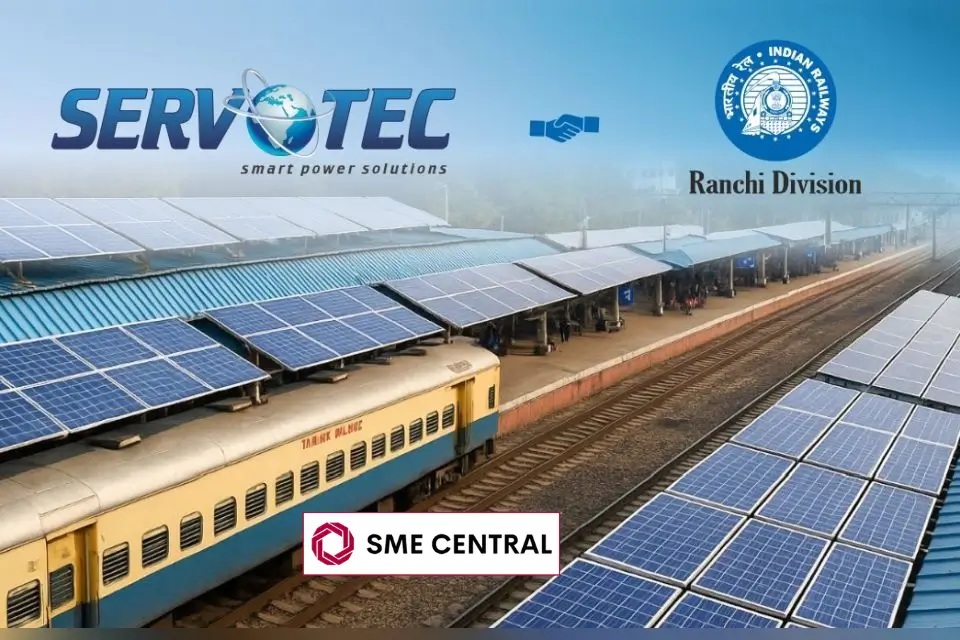Servotech Renewable Power System, a leading player in India’s renewable energy and EV charging space, has bagged a major 2.58 MW grid-connected rooftop solar project from South Eastern Railway (Ranchi Division). This is another big step in Indian Railways’ journey to achieve net-zero carbon and Servotech is a trusted execution partner in India’s clean energy journey.
Servotech’s Indian Railways Ranchi Division Project Details
Under the awarded contract, Servotech will handle end-to-end execution of on-grid rooftop solar photovoltaic (PV) system. This includes design, manufacturing, supply, installation, testing and commissioning of solar panels across multiple sites in Ranchi Division.
The distributed nature of the installations is a reflection of the government’s push for site specific solar generation which enhances grid stability and reduces transmission losses. Though the actual contract value is not disclosed, projects of this size are in the multi-crore range and Indian Railways is allocating more and more capital to renewable infrastructure.
What this means for Servotech Renewable
This is not a one-off project but part of a larger story for Servotech. In the last two years, the company has transitioned from a conventional electronics manufacturer to an integrated renewable technology company with offerings in EV charging infrastructure, solar energy solutions and smart power systems.
Director Sarika Bhatia said, “We are honoured to work with Indian Railways again in their journey to a cleaner and greener future.” This highlights Servotech’s growing presence in public sector renewable collaborations which often act as a launchpad for larger grid projects.
The company’s past experience with NTPC, IOCL and other government linked organizations has given investors more confidence that Servotech’s growth story is aligned with India’s 500 GW renewable energy target by 2030.
Indian Railways and the Sustainability Mandate
Indian Railways, one of the largest rail networks in the world, has set a target to become net-zero by 2030. Rooftop solar across divisions like Ranchi under South Eastern Railway is a key part of that strategy. By deploying distributed solar on station buildings, depots and offices, Railways will reduce their carbon footprint and long term energy costs. This is part of a multi phased solar roadmap which already has partnerships with various EPC and technology providers.
Market and Investment View
From market perspective this order can be a positive trigger for Servotech stock as investors start to price in renewable linked contracts as a sign of sustained revenue growth. The win also showcases the company’s technical expertise in hybrid domains — solar engineering with digital monitoring and control systems — where traditional EPC companies are lagging behind. As the government and PSUs are procuring renewables, Servotech is positioning itself as a next gen green technology partner rather than a conventional contractor.
Verdict
This consolidates Servotech’s position in the Indian renewable space and may indicate better quarterly performance going forward. If executed well, this project will not only give recurring revenue through maintenance contracts but will also give Servotech a credibility to bid for larger solar EPC tenders.
In the larger landscape, such public sector contracts are a validation mechanism for private renewable companies navigating a competitive market. For investors, this is a clear indication that Servotech is moving beyond EV charging and into large solar integration, a diversification that will help in stabilizing earnings in a rapidly changing energy landscape.
Conclusion
Servotech’s Ranchi Division order marks a significant intersection of policy, technology, and sustainability. It reflects how Indian enterprises are aligning with national clean energy goals and how companies like Servotech are leveraging innovation to drive real impact in the renewable space.
As India accelerates toward its green transition, partnerships like these underscore a new industrial narrative — one where energy independence, technological innovation, and corporate responsibility converge.

